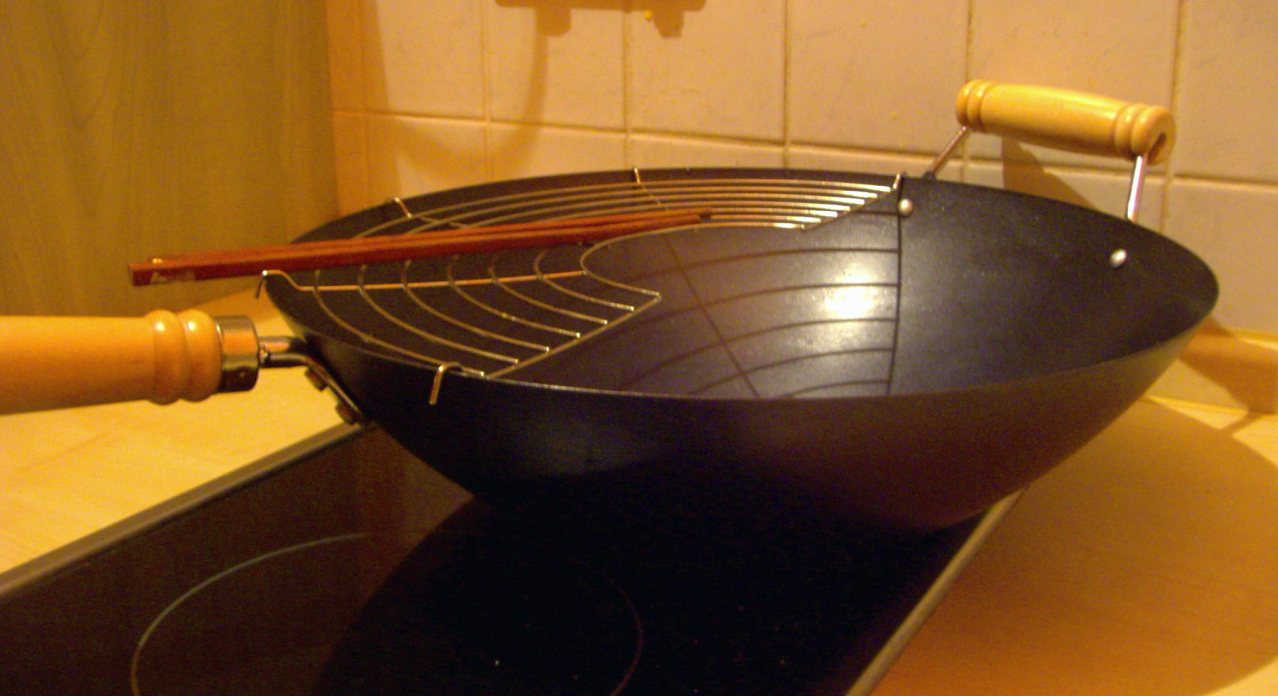A wok is a fun and useful addition to your kitchen arsenal, but it also requires maintenance. You don’t just slap it on the stove, heat up some food, then shove it in the dishwasher. It requires finesse. Cooking with a wok can also be complicated if you’ve never done it before. If you want to use one, the first step is picking the right wok to begin with.
Illustration by Angelica Alzona
Go With a Carbon Steel Wok
Your wok’s material matters and most experts agree: carbon steel is the way to go. Woks are made for high-heat, stir-fry cooking, and stir-fry cooking requires quick temperature changes. In order for food to reach the perfect consistency, it needs to be seared with quick, high heat. Carbon steel allows for this. It heats up and cools down quickly.
You don’t want stainless steel or anything with a manufactured nonstick surface. For one, stainless steel takes too long to heat up and cool down. Plus, as our own Claire Lower told me, most nonstick surfaces degrade at super high temperatures and can also keep food from browning.
Serious Eats says cast iron is better than stainless steel, but cast iron woks can still take a long time to heat up and cool down. They’re also fragile. Your best bet is carbon steel, and they recommend a wok that’s at least 2mm thick for durability.
Pick the Right Surface and Shape

Beyond the material, you want to look at how the wok is manufactured. Most standard carbon steel woks you see at department stores are spun, meaning they will have thin, subtle concentric circles around the wok. This makes it easier to push food to the sides of the wok. Other woks are hand-hammered for this very reason. Both are solid options, you just want to stay away from any woks with a completely smooth, slippery, obviously machined or polished surface.
Finally, woks come in different shapes and sizes. Some woks have rounded bottoms, and they’re great for making sure flames and heat get all around the sides of the wok. Of course, if you’re cooking on your regular, old residential stove, that’s not really possible anyway. Plus, you’d have to use a wok ring which concentrates the heat to the bottom of the wok. Award-winning author and wok expert Grace Young recommends a “36cm, flat-bottom carbon steel wok.”
As Lower mentioned, though, woks with bottoms that are too flat kind of seem pointless. Like the wok in the above photo, you want one that’s not completely flat but just flat enough to stay on your stove.
Wok handles come in two different styles. Cantonese-style woks have one small handle on each side of the wok. Again, this is traditional, but it doesn’t work well for cooking stir fry on your stove at home. Northern-style woks have a long wooden handle with a small one on the opposite side. This is what Young recommends, as it makes it easier to manage the wok and flip your ingredients.
Clean and Season Your Brand New Wok
Once you’ve found the perfect wok, it’s time to get that thing clean. Most woks are made with a protective coating to keep them looking fresh in-store. You want to remove this layer before using your wok for the first time. Scrub the wok with soapy water, dry it, and then heat it up on the stove at medium heat to completely evaporate any remaining water so it doesn’t rust.
Over time, your wok will develop a patina, layer of seasoning that adds flavour to your cooking. When your wok is new, you can season it yourself. Young shows you how it’s done in the above video. Basically, though, you heat your wok on high and pour some corn, vegetable, or peanut oil into the bottom of the wok. You don’t want to use olive oil, though, because its smoke point is too low.
From there, some cooks will simply wipe the sides of the pan with the oil using a paper towel and a pair of tongs. As Young demonstrates, you could also add some ginger or scallions (more on why later.) The process should take about 15 to 20 minutes. After cooking, rinse out the wok with water and a sponge.
After using your wok for a while, it might develop some discoloration from seasoning. As Young explains, this is normal:
Just like a cast-iron pan, the more you use a wok, the more flavour it will take on, and the better your food will taste. As you cook with the wok, the metal pores open, and the fat you’re cooking with seeps in. The discoloration a seasoned wok sports is fine — don’t scrub it off! “You think you’ve ruined the new pan,” says Grace, “but after a few months, I call it the adolescent wok.”
According to most experts, the only time you should use soap to clean your wok is during this first cleaning and if it develops rust. Otherwise, just rinse with water and sponge. Young also says you should avoid using vinegar, tomatoes or any other acidic food with a new wok because it can pull off that flavorful patina.
Cooking With a Wok
Wok cooking could be an entirely separate post, but if you’re new at it, here are some basics to get you started.
First, when it comes to stir-fry, you want to master the art of tumbling in your wok. Epicurious explains how this works in a nutshell:
Rocking the wok and turning your ingredients is key to getting your stir fry cooked evenly. “Each time I cook in a skillet, I’m just chasing the food, pushing it around,” says Young. “But if I put it in the wok, I can actually lift all of the food and tumble it.”
Before you go tossing in your ingredients, though, make sure your wok is at the right temperature — blazing hot. Flick a little water in the wok and if it sizzles and quickly evaporates, it’s hot enough to stir-fry your ingredients.
Again, woks are designed to withstand the incredibly high heat you need for stir-fry. The problem is your common at-home stove just doesn’t get hot enough for the proper wok hei — the essence for perfectly flavorful, smoky wok cooking. If you don’t have a professional high-end stove, most experts recommend cooking in batches. Here’s what Serious Eats suggests:
You want to use batches that are small enough that the meat or vegetables can really sear, their exuded juices evaporating rapidly instead of bubbling and simmering. For an electric burner, that may mean as little as, say, a quarter pound of meat at a time. This is not a problem, it just means your stir-fry will take a little bit longer. Get the wok smoking hot, cook the batch of meat, transfer it to a bowl, wipe out the wok, and repeat until all your meat is seared and in the bowl. Next, do the same for all your vegetables. Finally, heat up the wok again, stir-fry your aromatics, add the meat and vegetables back to the pan along with your sauce, toss to coat and to reduce a bit, and you’re good to go.
There’s a lot more that goes into wok cooking, of course, but these basics can help you get started. Most importantly, though, you want to make sure you’re working with the right wok to begin with.
Photos: By Dirk BroßkeDirkb (Wikimedia Commons)

Comments